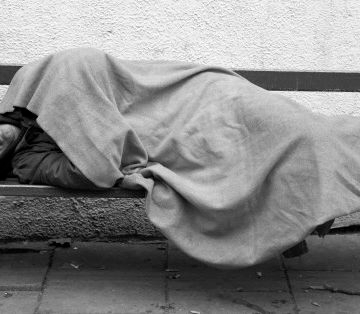
Monday afternoon, a slightly disheveled, elderly man approached what will be his new studio apartment, for his first time. His few belongings in his hands, he walked into the space and looked around it, appraising. Nodding to himself, he took off his coat, and without a word, hung it on a hook in the closet.
Okay, I wasn’t there, and that’s an admittedly dramatized version of what happened. But it is, as they say, “based on fact.”
What was remarkable about this move wasn’t the space, but rather its new occupant:Jasper, a man who suffered homelessness for decades. Jasper, a college-educated veteran of the US military. Jasper, a man who has slept on our streets since 1970. (And when I say “slept on our streets,” that’s not an euphemism. He slept in doorways, under bridges, in parking lots and once, he told me, in a large industrial dryer (although he said he couldn’t get his legs all the way in)).
Forty-five years, with random access to toilets. Unable to fall asleep behind a door he could lock, since Richard Nixon was president.
Honestly, I never, ever thought he would move into a space of his own. In the years I’ve known him, I’ve seen him refuse our assistance, again and again. In the industry, we identify that type of client as “treatment resistant.”
What does that mean? “Treatment resistant” means that when a polar vortex descends, and John, our Outreach Specialist, goes to find Jasper at night, to try to get him to a shelter, Jasper waves him off and says he’ll just sleep in a garage basement. It means that when my boss, Sue, tells Jasper he can have an apartment but doesn’t have to stay there all the time, he scoffs at her and says it’d be a waste of money. It means that when Andrea, our social worker, sets up an interview for him with a potential housing placement, he agrees to it but then doesn’t show up.
I’d seen these exchanges play out for months, for years. And I tell you, I thought that when we collectively meet the goal of ending veteran homelessness in our community by 2016—and we will—that Jasper would be the last man standing. Oh, I believe deeply in Bethesda Cares’ mission and work. But I didn’t think this guy would trust us, trust anyone, enough to accept the help he needed.
I was wrong. I was wrong! And I now see why: I was looking at the negatives I saw in his relationship with our outreach team, every time Jasper rejected help. But what if I gave it a positive spin? What if I looked at the ways our team kept offering it?
John knew Jasper’s hidey-holes, and tried to keep him safe. Jasper saw that. Sue knew his anxieties about being tethered to housing, so she offered him a new way of thinking of it. Jasper heard that. And Andrea? Let me tell you what she did, even after Jasper couldn’t bring himself to attend those housing interviews.
Andrea showed up for him, so visibly that even he could see it. Last Monday, Andrea drove to the local courthouse, and sat there for four hours, until Jasper was released from trespass charges (note to society: people might trespass less if they had, say, a few square feet to call their own). She walked him to her car, in which she had a clean change of clothes for him and a care package of personal items she knew he’d like. She drove him to his new place, stopping twice when he was carsick, from the unfamiliar motion, from anxiety, from excitement. She helped him through the paperwork and was there when he opened his own door. Mark, our Critical Time Intervention Specialist, arrived to start the process of supporting Jasper’s transition.
And what did he do? What did Jasper do, when he had his own space for the first time since the Beatles broke up?
He walked in that room, and claimed the both the space and the beginnings of a return to dignity, as his own. He simply hung up his coat.
So a big hats off to our Outreach Team, who showed me what skill and patience can do, who proved to me that true outreach can reach anyone. Can reach everyone. You ever hear that old chestnut, coined in a casino? When the odds are against you, never bet against the house.